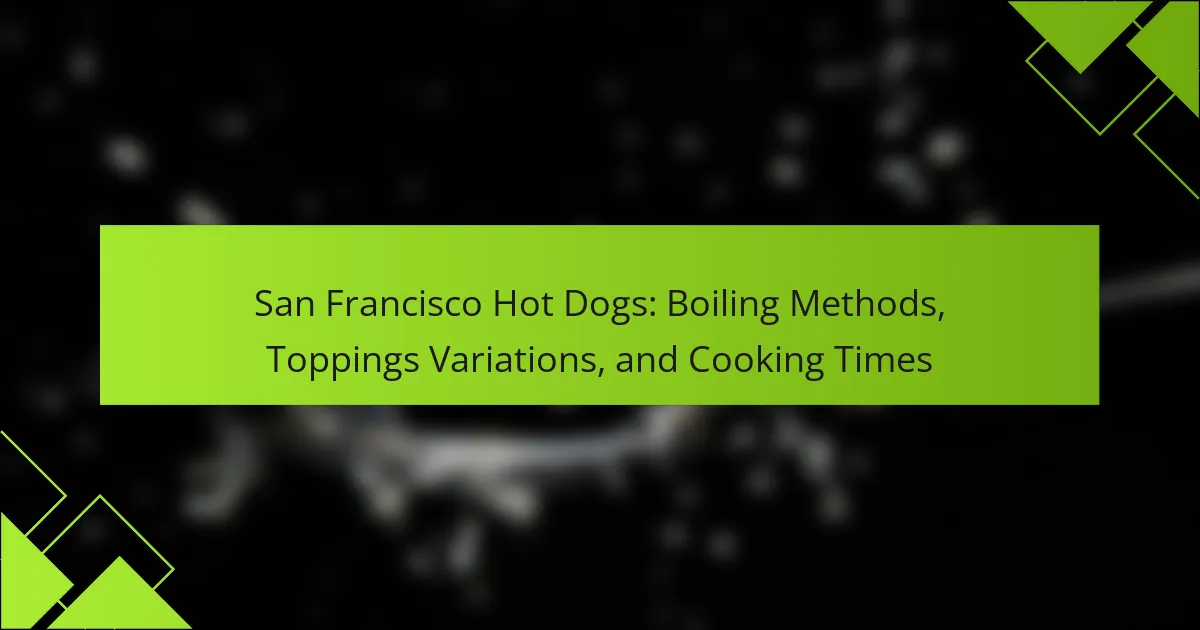San Francisco Hot Dogs are a distinctive style of hot dog characterized by their soft, fresh buns and a variety of toppings that reflect the city’s diverse culinary influences. Common toppings include grilled onions, mustard, sauerkraut, jalapeños, creamy avocado, and fresh cilantro. The hot dogs are typically prepared using two boiling methods: traditional boiling, which involves simmering in water, and steam boiling, which enhances flavor and texture. This article explores the preparation techniques, topping variations, and cooking times associated with San Francisco Hot Dogs, highlighting their unique place in the city’s food culture.

What are San Francisco Hot Dogs?
San Francisco Hot Dogs are a unique style of hot dog popular in San Francisco. They are typically served in a soft, fresh bun. These hot dogs are often topped with a variety of ingredients. Common toppings include grilled onions, mustard, and various sauces. The preparation method often involves boiling the hot dogs before serving. This boiling method helps to enhance their flavor and texture. San Francisco Hot Dogs are known for their distinct regional flair. They reflect the city’s diverse culinary influences.
How do San Francisco Hot Dogs differ from other hot dog styles?
San Francisco Hot Dogs differ from other hot dog styles primarily in their unique toppings and preparation methods. They often feature a variety of gourmet toppings, such as grilled onions, garlic, and specialty sauces. This contrasts with more traditional styles that typically use mustard, ketchup, or relish. The cooking method for San Francisco Hot Dogs often includes boiling the sausages before grilling them, which enhances their flavor and juiciness. In comparison, many other hot dog styles may focus solely on grilling or steaming. Additionally, San Francisco Hot Dogs are frequently served in a distinctive sourdough bun, adding a unique texture and taste. This is not commonly found in other regional hot dog variations.
What unique ingredients are commonly used in San Francisco Hot Dogs?
San Francisco Hot Dogs commonly feature unique ingredients such as grilled onions, sourdough bread, and jalapeños. Grilled onions add a sweet and savory flavor. Sourdough bread offers a distinct tangy taste and chewy texture. Jalapeños provide a spicy kick. These ingredients reflect the local culinary influences. They enhance the overall flavor profile of the hot dog. This combination is popular among street vendors and local eateries.
How does the cultural influence shape San Francisco Hot Dogs?
Cultural influence shapes San Francisco hot dogs through diverse toppings and preparation styles. The city’s rich immigrant history introduces unique flavors. For example, Asian influences lead to toppings like kimchi and sriracha. Additionally, local ingredients reflect California cuisine trends. Gourmet hot dog vendors often incorporate organic and artisanal elements. The fusion of cultures creates innovative combinations, appealing to a wide audience. Festivals and food trucks showcase these variations, further promoting cultural diversity. This blend of traditions enhances the overall hot dog experience in San Francisco.
What are the historical roots of San Francisco Hot Dogs?
San Francisco hot dogs originated in the early 20th century. They became popular among German immigrants who settled in the city. The hot dog stands emerged during the 1906 earthquake and fire, providing quick meals to displaced residents. These stands offered various toppings, reflecting the city’s diverse culinary influences. By the 1920s, hot dogs were a staple at local events and ballparks. The city’s unique approach to hot dogs includes distinctive toppings like sauerkraut and spicy mustard. This combination highlights San Francisco’s culinary creativity and cultural diversity. Today, hot dogs remain a beloved street food in the city.
When did San Francisco Hot Dogs first become popular?
San Francisco Hot Dogs first became popular in the early 1900s. Street vendors began selling them at various events and locations. The 1915 Panama-Pacific International Exposition significantly boosted their popularity. This event introduced many visitors to the local cuisine, including hot dogs. Over the years, they evolved with unique toppings and preparation methods. Today, they are a staple in San Francisco’s culinary scene. The city’s diverse culture contributed to the variety of flavors and styles.
Who are the key figures in the history of San Francisco Hot Dogs?
The key figures in the history of San Francisco Hot Dogs include street vendors and local entrepreneurs. Notable vendors like the late 19th-century German immigrants popularized hot dogs in the city. They introduced various toppings and styles that became local favorites. In the 1920s, the establishment of hot dog stands further solidified their presence. Figures such as the owner of the famous “Hot Dog King” stand contributed to the hot dog culture. Their influence helped shape the unique flavor profile of San Francisco Hot Dogs. The combination of diverse cultural influences led to innovative variations. This evolution continues to impact the local food scene today.

What boiling methods are used for San Francisco Hot Dogs?
San Francisco Hot Dogs are typically boiled using two main methods: traditional boiling and steam boiling. Traditional boiling involves submerging the hot dogs in simmering water until heated through. This method ensures even cooking and retains moisture. Steam boiling, on the other hand, uses steam to cook the hot dogs, which can enhance flavor and texture. Both methods are effective in preparing San Francisco Hot Dogs for serving. These techniques are widely used by vendors and restaurants in San Francisco, contributing to the city’s unique hot dog culture.
How does boiling affect the flavor and texture of hot dogs?
Boiling hot dogs primarily enhances their juiciness while affecting their flavor and texture. The boiling process cooks the hot dogs evenly, ensuring that they retain moisture. This moisture contributes to a tender texture, making the hot dogs easier to bite into. Additionally, boiling can dilute some of the seasoning flavors, resulting in a milder taste compared to grilling or frying. The water used in boiling can also absorb some of the natural flavors from the hot dogs, leading to a less intense flavor profile. Overall, boiling is an effective method for achieving a soft texture, but it may compromise the flavor intensity.
What are the different boiling techniques used in San Francisco?
The different boiling techniques used in San Francisco include traditional boiling, steaming, and poaching. Traditional boiling involves immersing hot dogs in boiling water for a set time. Steaming is a method where hot dogs are placed in a steamer basket over boiling water. Poaching involves cooking hot dogs in simmering water, which allows for a gentler cooking process. Each technique influences the texture and flavor of the hot dogs. For instance, boiling tends to make them plumper, while steaming retains moisture without overcooking. These methods are commonly used in various hot dog stands throughout San Francisco.
What is the recommended boiling time for different types of hot dogs?
The recommended boiling time for different types of hot dogs is typically 5 to 7 minutes. This duration applies to standard beef or pork hot dogs. For turkey or chicken hot dogs, the boiling time is generally about 6 to 8 minutes. If using frozen hot dogs, increase the boiling time to 8 to 10 minutes. Boiling ensures that the hot dogs are heated thoroughly and are safe to eat. This method also helps to retain moisture and flavor.
What equipment is needed for boiling San Francisco Hot Dogs?
A large pot is needed for boiling San Francisco Hot Dogs. This pot should have enough capacity to hold multiple hot dogs and water. A heat source, such as a stove, is essential to bring the water to a boil. A slotted spoon or tongs is useful for safely removing the hot dogs from the boiling water. A thermometer can help ensure the water reaches the appropriate boiling temperature. These pieces of equipment are standard for boiling hot dogs effectively.
What type of pot is best for boiling hot dogs?
A large stockpot is best for boiling hot dogs. This type of pot allows ample space for water and multiple hot dogs. Stockpots typically have a high capacity, often ranging from 6 to 12 quarts. They are designed for even heat distribution, which helps cook the hot dogs thoroughly. The material of a stockpot, often stainless steel or aluminum, provides durability and heat conductivity. Using a lid can help the water boil faster, improving efficiency. Additionally, a stockpot’s wide base allows for easy stirring and prevents overcrowding.
Are there any special tools that enhance the boiling process?
Yes, special tools can enhance the boiling process. A boiling pot with a lid increases heat retention. A thermometer ensures water reaches optimal boiling temperature. A pasta insert allows for easy removal of hot dogs. A steamer basket can also be used to prevent direct contact with boiling water. These tools improve efficiency and safety during cooking.

What are the variations of toppings for San Francisco Hot Dogs?
San Francisco Hot Dogs feature a variety of unique toppings. Common options include sauerkraut, mustard, and onions. Many vendors also offer jalapeños for a spicy kick. Some hot dogs are topped with creamy avocado or guacamole. Fresh cilantro is often added for flavor. Additionally, some variations include pickled vegetables or chili. These toppings reflect the diverse culinary influences in San Francisco. The combination of toppings creates a distinct flavor profile for each hot dog.
What are the most popular toppings for San Francisco Hot Dogs?
The most popular toppings for San Francisco hot dogs include sauerkraut, grilled onions, and spicy mustard. These toppings reflect the city’s culinary influences and preferences. Additionally, toppings like jalapeños and relish are also commonly used. The combination of these toppings creates a unique flavor profile. Sauerkraut adds a tangy crunch, while grilled onions provide sweetness. Spicy mustard enhances the overall taste with heat. These toppings are often found at local hot dog stands and food trucks. They contribute to the distinctive San Francisco hot dog experience.
How do local ingredients influence topping choices?
Local ingredients significantly influence topping choices for San Francisco hot dogs. The availability of fresh, local produce encourages unique topping combinations. For example, local avocados and artisan cheeses are popular due to their proximity to farms. Seasonal ingredients also dictate what toppings are favored at different times of the year. This practice supports local economies and promotes sustainability. Furthermore, regional culinary traditions shape topping preferences, such as the use of sourdough bread. The emphasis on local flavors creates a distinctive identity for San Francisco hot dogs. Overall, local ingredients enhance the diversity and creativity of topping options.
What unique toppings are exclusive to San Francisco?
Unique toppings exclusive to San Francisco include sourdough bread, crab, and garlic aioli. Sourdough bread is a local staple, often used as a bun alternative. Crab is a seafood delicacy from the Bay Area, providing a unique flavor. Garlic aioli adds a distinct garlic-rich taste, popular in local cuisine. These toppings reflect the city’s culinary heritage and local ingredients. They are not commonly found in hot dogs from other regions.
How do toppings affect the overall experience of eating a hot dog?
Toppings significantly enhance the overall experience of eating a hot dog. They add flavor, texture, and visual appeal. Common toppings include mustard, ketchup, onions, and relish. Each topping contributes unique taste profiles. For example, mustard adds tanginess, while ketchup offers sweetness. The choice of toppings can cater to personal preferences. Additionally, toppings can elevate the nutritional value of a hot dog. Vegetables like onions and peppers provide vitamins and minerals. A study by the National Hot Dog and Sausage Council highlights that toppings influence consumer satisfaction. This indicates that well-chosen toppings can improve the enjoyment of the hot dog experience.
What flavor profiles do different toppings bring to San Francisco Hot Dogs?
Different toppings bring distinct flavor profiles to San Francisco Hot Dogs. For instance, sauerkraut adds a tangy and sour note. This contrasts with sweet onions, which provide a mild sweetness. Mustard introduces a sharp and spicy flavor, enhancing the overall taste. Relish offers a sweet and slightly tart profile, complementing the hot dog. Jalapeños contribute heat and a fresh, crisp texture. Cheese adds a creamy richness, balancing the spiciness of other toppings. Each topping uniquely influences the overall flavor experience of the hot dog.
How can toppings be paired to enhance the dining experience?
Toppings can be paired to enhance the dining experience by complementing the flavors of the hot dog. For instance, spicy toppings like jalapeños can balance milder flavors such as cream cheese. Sweet toppings like caramelized onions can add depth to savory meats. Textural contrasts also play a role; crunchy toppings like coleslaw can enhance the overall mouthfeel.
Pairing acidic toppings, such as pickles or sauerkraut, can cut through richness, providing a refreshing contrast. Regional toppings can reflect local culinary traditions, adding cultural significance to the meal. For example, San Francisco-style toppings often include unique ingredients like avocado or specialty mustards. These combinations create a more dynamic and enjoyable dining experience.
What are some tips for creating the perfect San Francisco Hot Dog?
To create the perfect San Francisco Hot Dog, start with high-quality ingredients. Use a fresh, locally sourced hot dog for the best flavor. Opt for a soft, steamed bun that complements the dog. For toppings, consider classic options like mustard, onions, and relish. You can also add unique San Francisco twists such as pickled jalapeños or garlic aioli. Ensure the hot dog is cooked thoroughly, typically by boiling or grilling. Serve immediately for optimal taste and texture. These elements contribute to the iconic San Francisco Hot Dog experience.
San Francisco Hot Dogs are a distinctive culinary entity characterized by their unique toppings, preparation methods, and local ingredients. This article explores the various boiling techniques used to prepare these hot dogs, such as traditional boiling and steam boiling, along with the recommended cooking times for different types. It also delves into the diverse topping variations that enhance the flavor profile, including local favorites like sourdough bread and crab. Additionally, the historical roots and cultural influences shaping San Francisco Hot Dogs are examined, providing a comprehensive understanding of this popular street food.
